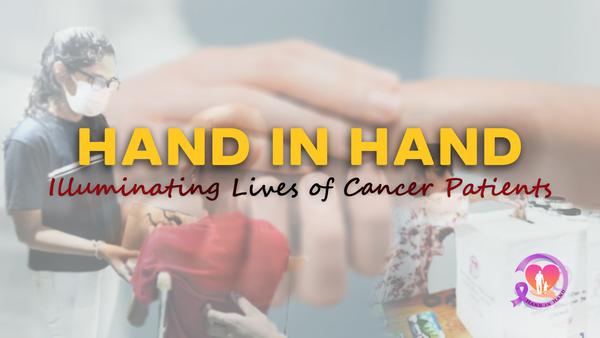Let's fight against cancer: Types of Cancer - Colorectal Cancer
According to World Health Organization, Colorectal cancer is one of the most common cancer in the world in 2018, with 1.80 million newly diagnosed cases. During 2018, 862,000 deaths were caused by this cancer. In Sri Lanka, Colorectal cancer is the 4th most common cancer in male. 734 new Colorectal cancer cases in males were diagnosed in 2018 and it is 6.9% of all cancer cases.
Colorectal cancer begins in the colon or rectum. The large intestine (or large bowel), which is part of the digestive system, is made up of the colon and rectum. The colon is a muscular tube about 1.5m long. Food is carried through them in different ways by different parts of the large intestine.
Most colorectal cancers begin as a growth on the inside of the colon or rectum. These abnormal tissue growths are called polyps which most often looks like small, flat bumps stalks.
Some types of polyps can turn into cancer over time (usually years), but not all polyps turn into cancer. The chance of developing a polyp depends on the type of polyp.
Types of cancer in the colon and rectum
Most colorectal cancers are adenocarcinomas. These cancers start with cells that produce mucus to lubricate the inside of the colon and rectum.
Other, less common cancers can also start in the colon and rectum.
Carcinoid tumors
These start with hormone-producing cells in the colon. These cancers can start in the gastrointestinal system (the stomach, intestine, appendix, colon, or rectum). These tumors usually occurs predominantly in the lungs and the pancreas whilst it can develop in other the organs too.
Gastrointestinal stromal tumors
These cancers originate from special cells in the lining of the large intestine, called interstitial cells of Cajal. Some of them are not cancer. These cancers can be found anywhere in the digestive system but are not common in the large intestine.
Lymphoma
This is a cancer of the cells of the immune system. They often start with lymph nodes, but they can also start in the large intestine, rectum, and other organs.
Sarcoma
It can begin with blood vessels, muscles, or other connective tissue in the large intestine and rectal wall. Sarcoma of the large intestine or rectum is rare.
Colorectal Cancer Signs and Symptoms
· A persistent change in your bowel habits, including diarrhea or constipation or a change in the consistency of your feces
· Rectal bleeding in your feces
· Frequent abdominal discomfort, such as cramps, gas or pain
· A feeling that your bowel doesn't empty completely
· Weakness or fatigue
· Unexplained weight loss
Colorectal Cancer Risk Factors
· Being overweight or obese
· Not being physically active
· Certain types of diets – A diet high in red meat (such as beef, pork, lamb) and processed meats (hot dogs) increases your risk of colon cancer.
· Smoking
· Alcohol
· Being older - Your risk of colorectal cancer goes up as you age (more common after age 50)
· A personal history of colorectal polyps or colorectal cancer
Can Colorectal Cancer Be Found Early?
Testing is the process of finding cancer or pre-cancer in people who have no symptoms of the disease. Regular colorectal cancer screening is one of the most powerful tools against colorectal cancer. By screening, doctors can find and remove polyps before they become cancerous.
There is no permanent way to prevent colon cancer. But there are things you can do to reduce your risk, such as changing risk factors that you can control.
Surgery is often the main treatment for early-stage Colorectal cancers. Also, this cancer can be treated with drugs that can be given through the mouth or directly into the bloodstream (systemic treatments). Because they can reach cancer cells almost anywhere in the body. Depending on the type of colorectal cancer, different types of drugs can be used: chemotherapy, targeted therapy, and immunotherapy for colon cancer.
Colorectal cancer awareness ribbon color: Dark blue
Colorectal cancer awareness month: March
ලෝක සෞඛ්ය සංවිධානයට අනුව, කොලරෙක්ටල් පිළිකා යනු 2018 දී ලොව සුලභම පිළිකාවක් වූ අතර අලුතින් හඳුනාගත් රෝගීන් මිලියන 1.80 කි. එම වසරේදී මෙම පිළිකාව හේතුවෙන් 862 000 මරණ සිදු වී ඇත.ශ්රී ලංකාවේ, කොලරෙක්ටල් පිළිකාව පිරිමින් අතර බහුලව දක්නට ලැබෙන පිළිකා වේ. 2018 දී පිරිමින්ගේ නව කොලරෙක්ටල් පිළිකා රෝගීන් 734 ක් හඳුනාගෙන ඇති අතර එය පිළිකා රෝගීන්ගෙන් 6.9% කි.
කොලරෙක්ටල් පිළිකා ආරම්භ වන්නේ මහා බඩවැලේ හෝ ගුද මාර්ගයේ ය. මහා බඩවැලේ හා ගුද මාර්ගය මගින් ආහාර ජීර්ණ පද්ධතියේ කොටසක් වන මහාන්ත්රය (මහා බඩවැල්) සෑදී ඇති අතර එය ආමාශ ආන්ත්රයික (GI) පද්ධතිය ලෙසද හැඳින්වේ. මහාන්ත්රයේ බොහෝමයක් සෑදී ඇත්තේ මහා බඩවැලෙනි, මාංශ පේශි නළයක් මීටර් 1.5පමණ දිගයි. මහා බඩවැලේ විවිධ කොටස් මගින් විවිධ ආකාරයෙන් ආහාර ඒවා හරහා රැගෙන යයි.
බොහෝ මහා බඩවැලේ පිළිකා ආරම්භ වන්නේ මහා බඩවැලේ හෝ ගුද මාර්ගයේ අභ්යන්තරයේ වර්ධනයක් වශයෙනි. මෙම අසාමාන්ය පටක වර්ධනය පොලිප්ස් ලෙස හැඳින්වෙන අතර එය බොහෝ විට කුඩා, පැතලි, ගැටිති ලෙස පෙනේ.
සමහර වර්ගවල පොලිප්ස් කාලයත් සමඟ පිළිකා බවට වෙනස් විය හැකිය.(සාමාන්යයෙන් අවුරුදු ගණනාවක්), නමුත් සියලුම පොලිප්ස් පිළිකා බවට පත් නොවේ. පොලිප්ස් පිළිකාවක් බවට පත්වීමේ අවස්ථාව රඳා පවතින්නේ එය කුමන ආකාරයේ පොලිප් වර්ගය මතද යන්නය.
මහා බඩවැලේ හා ගුද මාර්ගයේ පිළිකා වර්ග
කොලරෙක්ටල් පිළිකා බොහෝමයක් ඇඩිනොකාර්සිනෝමා වේ. මෙම පිළිකා ආරම්භ වන්නේ මහා බඩවැලේ හා ගුද මාර්ගයේ ඇතුළත ලිහිසි කිරීමට ශ්ලේෂ්මල නිපදවන සෛල වලිනි.
වෙනත්, බෙහෙවින් අඩු සුලබ පිළිකා වර්ග මහා බඩවැලේ හා ගුද මාර්ගයේ ද ආරම්භ විය හැකිය.
Carcinoid පිළිකා - මේවා ආරම්භ වන්නේ බඩවැලේ ඇති විශේෂිත හෝමෝන නිපදවන සෛල වලින්. මෙම පිළිකා ආමාශ ආන්ත්රයික පද්ධතියෙන් (ආමාශය, අන්ත්රය, උප ග්රන්ථය, මහා බඩවැල් හෝ ගුද මාර්ගයේ) ආරම්භ විය හැකිය. මෙම පිළිකා පෙනහළු හා අග්න්යාශයේ ද ආරම්භ විය හැකි අතර අනෙක් අවයව වල සුළු සංඛ්යාවක් වර්ධනය වේ.
Gastrointestinal stromal පිළිකා
මෙම පිළිකා ආරම්භ වන්නේ මහා බඩවැලේ බිත්තියේ ඇති විශේෂ සෛල වලින් වන අතර එය කැජල්හි අන්තර් සෛල ලෙස හැඳින්වේ. සමහර ඒවා පිළිකාවක් නොවේ. මෙම පිළිකා ආහාර ජීර්ණ පද්ධතියේ ඕනෑම තැනක සොයා ගත හැකි නමුත් මහා බඩවැලේ බහුලව දක්නට නොලැබේ.
ලිම්ෆෝමා
මෙම පිළිකා යනු ප්රතිශක්තිකරණ පද්ධතියේ සෛලවල පිළිකා වේ. ඒවා බොහෝ දුරට වසා ගැටිති වලින් ආරම්භ වන නමුත් ඒවා මහා බඩවැලේ, ගුද මාර්ගයේ හෝ වෙනත් අවයව වලින් ආරම්භ විය හැකිය.
සර්කෝමා
මහා බඩවැලේ හා ගුද මාර්ගයේ බිත්තියේ රුධිර නාල, මාංශ පේශි හෝ වෙනත් සම්බන්ධක පටක වලින් මෙම පිළිකා ආරම්භ විය හැකිය. මහා බඩවැලේ හෝ ගුද මාර්ගයේ සර්කෝමා දුර්ලභ වේ.
කොලරෙක්ටල් පිළිකා සංඥා සහ රෝග ලක්ෂණ
පාචනය හෝ මල බද්ධය ඇතුළුව ඔබේ බඩවැල්වල නිරන්තර වෙනසක් හෝ ඔබේ මළ මූත්රයේ අනුකූලතාවයේ වෙනසක්
ඔබේ මළ මූත්රා වල රුධිර වහනය
බඩේ අමාරුව, කැක්කුම, වායුව හෝ වේදනාව වැනි
ඔබේ බඩවැල් සම්පූර්ණයෙන්ම හිස් නොවන බවට හැඟීමක්
දුර්වලකම හෝ තෙහෙට්ටුව
පැහැදිලි කළ නොහැකි බර අඩු වීම
කොලරෙක්ටල් පිළිකා අවදානම් සාධක
අධික බර හෝ තරබාරු වීම
ශාරීරිකව ක්රියාකාරී නොවීම
සමහර ආහාර වර්ග - රතු මස් (හරක් මස්, ඌරු මස්, බැටළු මස් වැනි) සහ සැකසූ මස් (හොට් ඩෝග් වැනි) අධික ආහාර වේලක් මඟින් මහා බඩවැලේ පිළිකා ඇතිවීමේ අවදානම වැඩි කරයි.
දුම්පානය
මත්පැන් භාවිතය
වයසින් මුහුකුරා යාම - වයසට යත්ම මහා බඩවැලේ පිළිකා ඇතිවීමේ අවදානම ඉහළ යයි (වයස අවුරුදු 50 න් පසු වඩාත් සුලභ වේ)
කොලරෙක්ටල් පොලිප්ස් හෝ කොලරෙක්ටල් පිළිකා පිළිබඳ පෞද්ගලික ඉතිහාසයක්
කොලරෙක්ටල් පිළිකා කල්තියා සොයාගත හැකිද?
පරීක්ෂාව යනු රෝගයේ කිසිදු රෝග ලක්ෂණයක් නොමැති පුද්ගලයින් තුළ පිළිකා හෝ පූර්ව පිළිකා සෙවීමේ ක්රියාවලියයි. නිත්ය කොලරෙක්ටල් පිළිකා පරීක්ෂාව යනු කොලරෙක්ටල් පිළිකාවට එරෙහි ප්රබලතම මෙවලමකි.පරීක්ෂාවට ලක් කිරීමෙන් වෛද්යවරුන්ට පිළිකාවක් බවට පත්වීමට පෙර පොලිප්ස් සොයාගෙන ඉවත් කළ හැකිය.
මහා බඩවැලේ පිළිකා වැළැක්වීමට ස්ථිර ක්රමයක් නොමැත. නමුත් ඔබට පාලනය කළ හැකි අවදානම් සාධක වෙනස් කිරීම මගින් අවදානම අඩු කිරීමට ඔබට කළ හැකි දේවල් තිබේ.
මුල් අවධියේ මහා බඩවැලේ හා ගුද මාර්ග පිළිකා සඳහා ප්රධාන ප්රතිකාරය සැත්කම් වේ. කොලරෙක්ටල් පිළිකාවට මුඛයෙන් හෝ කෙලින්ම රුධිරයට ලබා දිය හැකි ඖෂධ භාවිතයෙන් ප්රතිකාර කළ හැකිය (පද්ධතිමය ප්රතිකාර). ශරීරයේ සෑම තැනකම පාහේ පිළිකා සෛල කරා ළඟා විය හැකිය. කොලරෙක්ටල් පිළිකා වර්ගය මත පදනම්ව, විවිධ වර්ගයේ ඖෂධ භාවිතා කළ හැකිය, ඒවා නම්: රසායනික චිකිත්සාව, ඉලක්කගත චිකිත්සාව සහ මහා බඩවැලේ පිළිකා සඳහා ප්රතිශක්ති චිකිත්සාව.
කොලරෙක්ටල් පිළිකා පිළිබඳ දැනුවත් කිරීමේ වර්ණය: තද නිල්
කොලරෙක්ටල් පිළිකා පිළිබඳ දැනුවත් කිරීමේ මාසය: මාර්තු
Check out our other blogs on cancer;
1) What is cancer: https://blog.rotaractmora.org/what-is-cancer/
2) What causes cancer: http://blog.rotaractmora.org/causes-of-cancer/
3) Childhood cancer: http://blog.rotaractmora.org/fight-against-cancer/
4) Leukemia: https://blog.rotaractmora.org/hih-cancer-leukemia/
5) Brain cancer: https://blog.rotaractmora.org/brain-cancer/
6) Lung cancer: https://blog.rotaractmora.org/lung-cancer/
7) Breast cancer: https://blog.rotaractmora.org/breast-cancer/
8) Skin cancer: http://blog.rotaractmora.org/skin-cancer/
9) Oral cancer: https://blog.rotaractmora.org/oral-cancer/
10) Thyroid cancer: https://blog.rotaractmora.org/thyroid-cancer-2/
11) Movie review- The fault in our stars: https://blog.rotaractmora.org/movie-review-the-fault-in-our-stars/
12) Cervical cancer: http://blog.rotaractmora.org/cervical-cancer/
13) Colorectal cancer: http://blog.rotaractmora.org/colorectal-cancer/
14) Movie review: My life without me: http://blog.rotaractmora.org/moviereviewmylifewithoutme/
15) Cancer health policy of WHO: http://blog.rotaractmora.org/health-policy-of-who/



